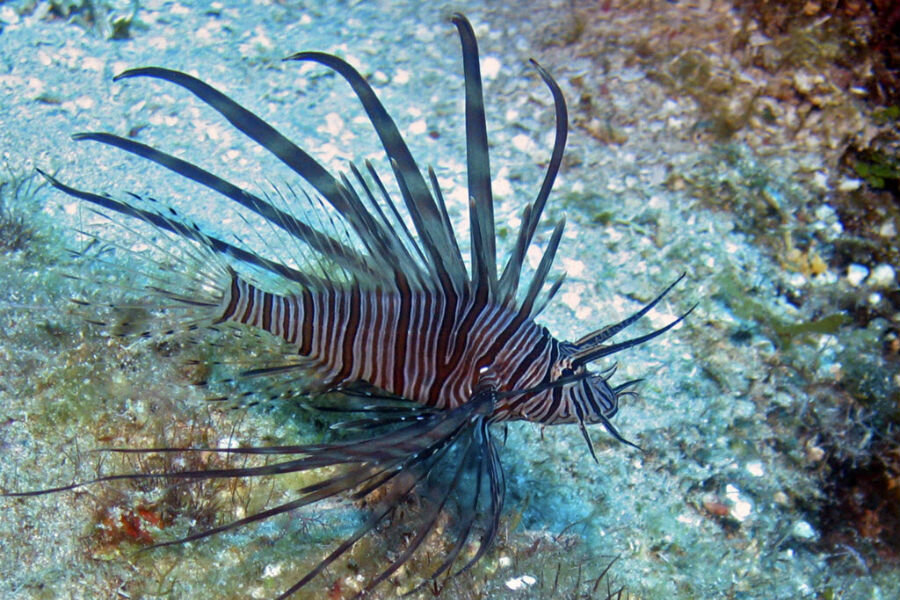As East Coast waters warm, an invader moves in
Warming ocean waters could be a boon to invasive marine species, such as the dazzling but rapacious lionfish, new research suggests.
As ocean temperatures rise, the range of many tropical fish could expand into more temperate waters, suggests research published in the September issue of Marine Ecology Progress Series.
Researchers from National Oceanic and Atmospheric Administration and the University of North Carolina in Wilmington, N.C. conducted a series of surveys of fish communities in North Carolina’s Onslow Bay between 2004 and 2010 with the intent of establishing a baseline snapshot of the populations of 40 fish species.
“You have to have a baseline in order to detect any changes that come in the future,” explains NOAA fisheries biologist Paula Whitfield and lead author of the study. “This baseline not only sets a quantitative estimate of the actual numbers of these different fish at these different locations but you also have the quantitative baseline of the temperature thresholds of these species.”
Scientists have studied fish communities in Onslow Bay for decades, but these latest surveys employed additional techniques not used in previous research, Ms. Whitfield told the Monitor. Previous studies relied mainly on angling and trawling to establish a census of fish dwelling in the bay; neither method is very good at finding small fish. Whitfield’s team used those methods as well, but also sent divers down to search for bottom dwellers hiding in the substrate.
During these surveys, one fish stood out: the invasive lionfish.
“We routinely looked underneath ledge overhangs and within crevices and found that in the hard bottom habitats of Onslow Bay, lionfish were easily visible either on top of the habitat structure, at the base/sand interface of ledges, or underneath overhangs,” the researchers wrote.
Whitfield was the first biologist to spot the lionfish in North Carolina waters while diving with some friends around a shipwreck in the bay in 2000.
“The first thing I thought was, ‘These guys don’t belong here; and if they’re here, they are everywhere,’ ” she recalls.
Lionfish are native to the South Pacific and Indian Oceans. However, in the 1990s, they started appearing in waters off the coast of Florida, after an aquarium broke during Hurricane Andrew in 1992, accidentally releasing a few breeding pairs into Biscayne Bay. Scientists believe that hobbyists have since released additional individuals into the ocean.
In the years since their introduction off the Florida coast, the lionfish has made itself at home, voraciously consuming native species and threatening the stability of coral ecosystems. They have become firmly established along the southeast coast as far north a Cape Hatteras. Some have been spotted just south of New England, but there they have not survived the cold winter waters – so far at least.
Whitfield and her team have singled out the lionfish as a key indicator species that could signal the alarm that ocean waters are warming if they start to overwinter further north.
“If lionfish become established year-round in areas previously known to be uninhabitable, then this could indicate that the thermal regime is shifting to favor more tropical species in general,” they wrote.
Ocean temperatures play a major role in defining the characteristics of fish communities. As waters warm as a result of climate change, fish communities migrate poleward in search of more amenable temperatures, says Jonathan Hare, a research fisheries biologist for NOAA’s Northeast Fisheries Service in Narragansett, R.I.
Recent studies off the coast of the northeastern United States have found that as many as two-thirds of the species examined have altered the range of their habitat in search of cooler waters, Mr. Hare says in an interview.
Scientists remain unsure whether such shifts among native species are harmful to the broader marine ecosystem, but range alterations among invasive species, such as the lionfish, can certainly have a negative impact.
In their natural habitat, lionfish populations are controlled by predation, disease, and other habitat-specific constraints. In Caribbean and Atlantic waters, temperature has so far been the only means of controlling their invasion, says Stephanie Green, a marine ecologist and post-doctoral associate at Oregon State University.
Reefs in Caribbean and southeastern US waters can tolerate some lionfish presence, but without any natural population checks they can – and often do – cause major declines in native reef communities, Dr. Green says in an interview.
Green’s research suggests that warmer temperatures could also accelerate the lionfish’s colonization rate.
“What happens to all animals when you crank up the temperature is they grow more quickly and they also eat more prey,” Green explains. “If warmer waters also helps these guys to expand their range, then we really will have a problem.”







